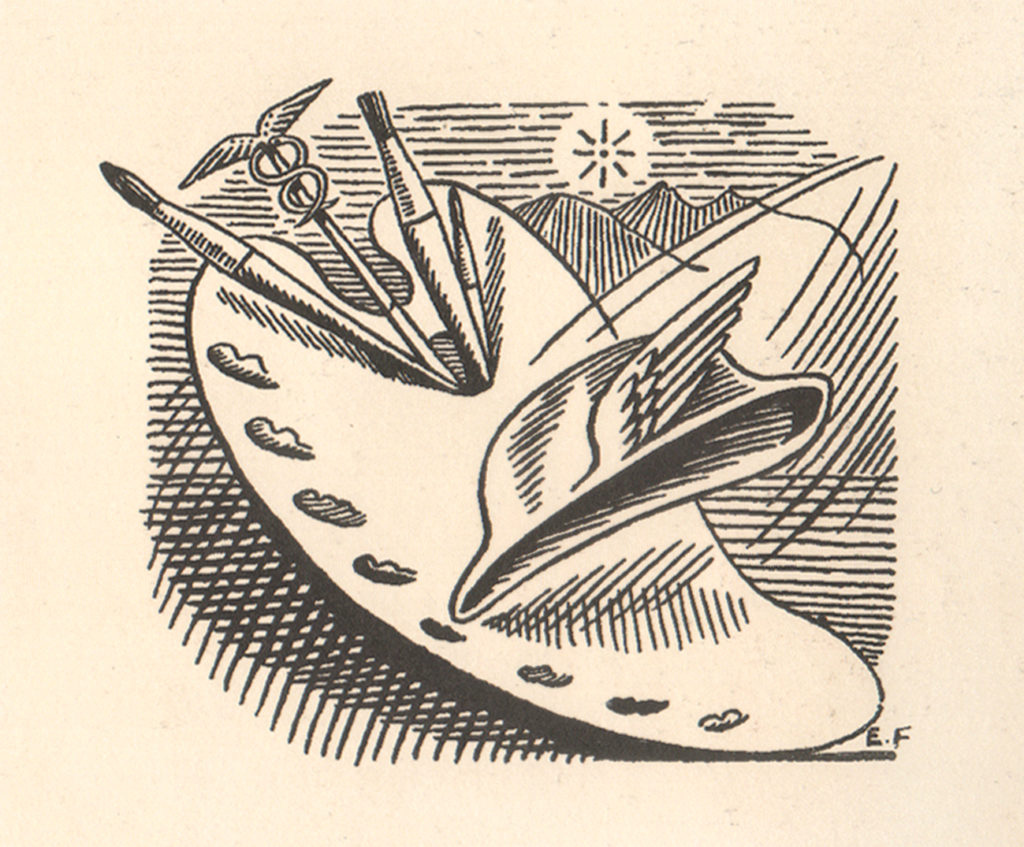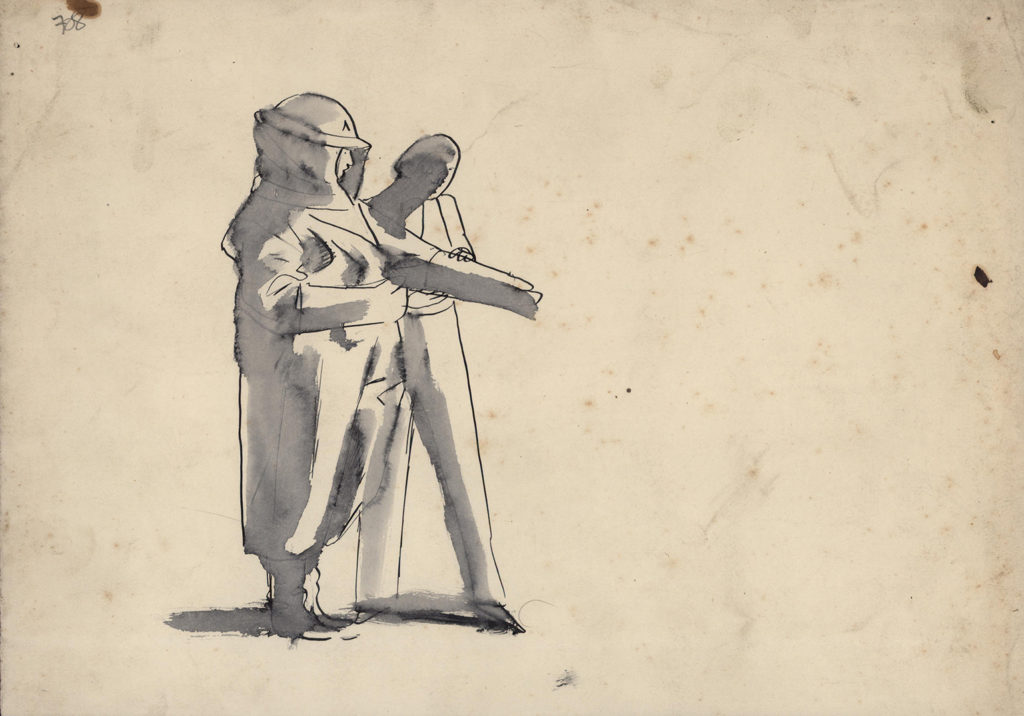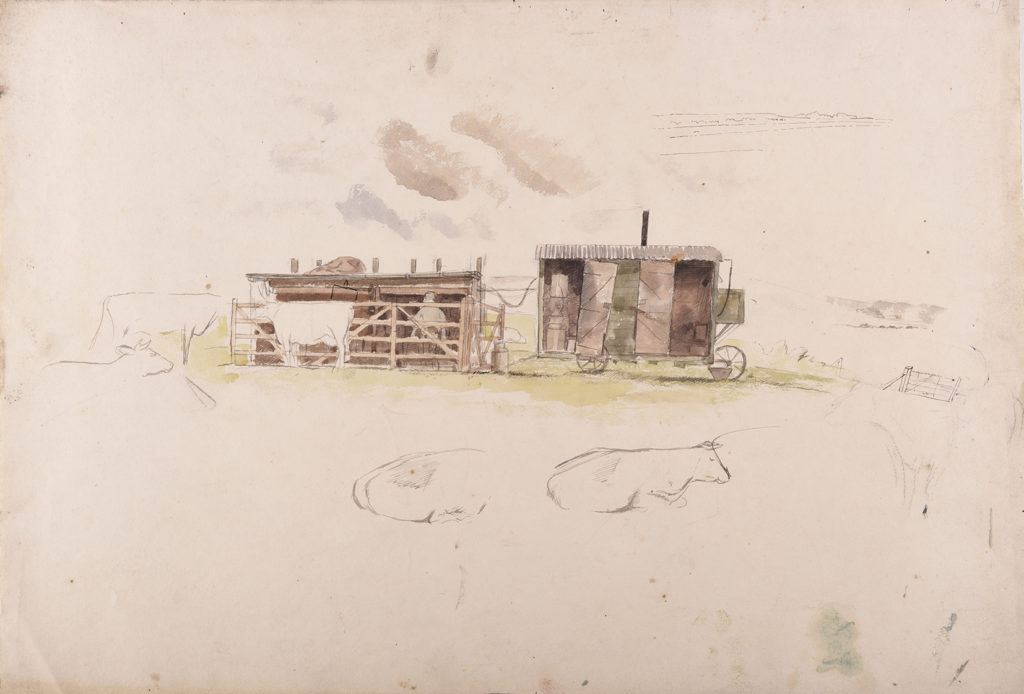In partnership with Liss Llewellyn Fine Art, Watts Contemporary near Guildford, United Kingdom, has crafted the first selling exhibition dedicated to a major figurative artist of the Modern British era. Details here!
On view now through September 24 at Watts Contemporary is a major retrospective dedicated to the life and career of Evelyn Dunbar (1906-1960), now considered to be among the most important artists in 20th-century British art. Bringing together 150 pictures — over half of which have never been shown publicly — the exhibition aims to highlight the artist’s importance and why her status has been vaulted to such heights.

The gallery has offered a wonderful, comprehensive overview of the artist’s career, which we’ve quoted in full here:
“Evelyn Dunbar was born in Reading, Berkshire, into a merchant family. In childhood she moved to Kent, where she lived for most of her life. While at school she won national awards for drawing. Between leaving Rochester Grammar School for Girls and going to art college she spent a year or two writing and illustrating children’s books, mostly featuring winsome children. ‘Hot Pie’ (1925), included in this exhibition, is a typical example.
“This early period is also notable for family portraits, of which ‘Sleeping Beauty’ (1928), an affectionate portrait of her father William, is an endearing example.
“Dunbar studied at the Royal College of Art, and between 1933 and 1936 she was amongst a team of recent graduates from the RCA who were invited by their tutor, Cyril (Charles) Mahoney, to create a mural design for the hall and adjacent areas of Brockley County Schools for Boys in Lewisham. Included in the exhibition are Dunbar’s sketches for a 12-meter frieze of the local landscape and for two of 24 spandrels illustrating Aesop’s fables and other moral instances.
“A close relationship developed between Dunbar and Mahoney, subsequently leading to the jointly written and illustrated Gardeners’ Choice (London: George Routledge & Sons, 1937). This exhibition includes several of Dunbar’s original drawings for the book, both of the plants featured and of the numerous and intriguing vignettes based on the garden at The Cedars, the Dunbar family home in Rochester.

“In 1937 Dunbar received a commission from Country Life to design its 1938 Gardener’s Diary. For this, Dunbar created particularly inventive pen-and-ink personifications of the months, each featuring the associated work or produce. This exhibition includes a study of September, seen as a doughty lady gardener surrounded by vegetable marrows and sunflowers.
“Evelyn Dunbar’s Christian Scientist background helped the artist to develop firm ideas about the interaction of mankind and nature. Initially limited to the context of the family garden in Kent, her ideas found a wider field of expression when, having been appointed Official War Artist in 1940 — Dunbar was the only woman war artist to be salaried throughout WW2 — she quickly became particularly associated with the Women’s Land Army. This exhibition features previously unseen studies for major paintings from this period, including ‘A Land Girl and the Bail Bull’ (1945, finished painting in the Tate collection) and ‘The Queue at the Fish Shop’ (1944, finished painting in the Imperial War Museum’s collection). These and other war pictures reveal how, in recording women’s Home Front activities, Dunbar could promote a gentle and unaggressive feminism.
“In 1940, the artist met and later married Roger Folley, then an RAF officer but later to become a leading horticultural economist. Their common interests and convictions encouraged Dunbar, after the war, to concentrate on a series of allegorical paintings and drawings which reflected her beliefs, and her debt to Ruskin and the Pre-Raphaelites, whose ideas about the function of art and the place of narrative in painting she acknowledged as strongly influential. Pen and Indian ink sketches for ‘Faith, Hope and Charity’ (1948) — with Charity characteristically faceless — show the beginnings of what might have become a major allegorical painting had Dunbar completed it. But never one to waste a good idea, her design eventually ended up as a Christmas card.

“Evelyn Dunbar divided her post-war years between allegories, teaching as a Visitor at the Ruskin School, exhibiting and, towards the end of her life, recording her beloved Kent in landscapes again expressive of the synergy between man and nature. ‘Kentish Landscape’ (1955) is a typical example, with agricultural activities omnipresent but subtly understated.
“Evelyn Dunbar died suddenly at the age of 53, leaving behind a studio collection of some 800 works which only came to light in 2013 when a painting by Dunbar appeared on the BBC Antiques Roadshow. Having seen the show, Ro Dunbar, a relative of the artist, set to exploring the extraordinary hoard of paintings, drawings and studies hidden in the attic of her Kent home. The unrecorded works were identified with the help of Christopher Campbell-Howes, the artist’s nephew and biographer (Evelyn Dunbar: A Life in Painting, on sale at the exhibition), who had been tracking contents of the ‘lost studio’ — dismantled in its entirety after Dunbar’s death in 1960 — for some 10 years. The discovery of the Hammer Mill Oast Collection doubled the known body of Dunbar’s work overnight and has enabled a reappraisal of the artist’s place in 20th century British art history.

“Commenting, Paul Liss, Director of Liss Lllewelyn Fine Art, appointed by the Dunbar Family to sell the Hammer Mill Oast Collection and organizer of the acclaimed museum exhibition Evelyn Dunbar: The Lost Works (Pallant House, 2015), said:
‘“Through a display of 150 works, this exciting exhibition at Watts Gallery-Artists’ Village examines all aspects of the output by Evelyn Dunbar. This is the largest group of works by Dunbar ever to be exhibited for sale.’
‘“To hold an exhibition of the work of Evelyn Dunbar at Watts Gallery-Artists’ Village is particularly apt. Whilst in so many ways Dunbar’s work is firmly rooted in the 20th century aesthetic of the interwar years she was also part of the last generation to receive an art school training firmly rooted in the ideals of the 19th century.’

‘“As such her approach to creativity had much in common with that of Watts, dependent on the human figure, on narrative and on the rules of formal composition. Unashamedly fascinated by art in all its forms (she produced book illustrations, needlework, shop signs, and murals, as well as easel paintings) her work will be naturally at home in the context of the Watts Artists’ Village.”
“Evelyn Dunbar: Studies, Illustrations and Paintings continues the Watts Contemporary program that provides a unique opportunity for visitors to discover and buy affordable art and craft that resonate with the Arts and Crafts heritage of Watts Gallery – Artists’ Village.”
To learn more, visit Watts Contemporary.
This article was featured in Fine Art Today, a weekly e-newsletter from Fine Art Connoisseur magazine. To start receiving Fine Art Today for free, click here.







